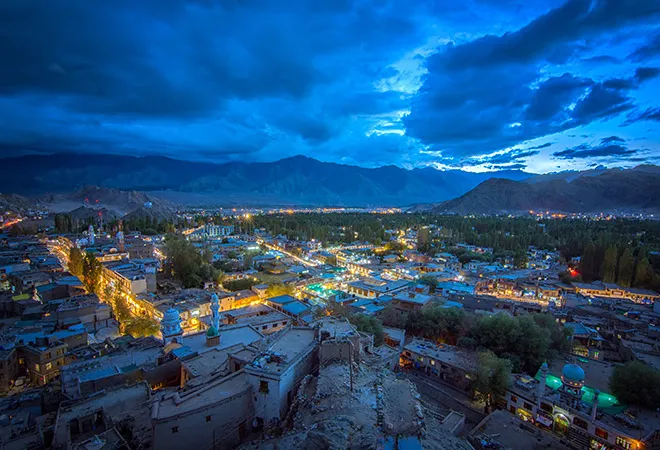-
CENTRES
Progammes & Centres
Location
Inclusion of environmental issues in manifestos has been a trend since the last general election. This time, there are even specific mentions of the North Eastern and Himalayan States.

Before the Indian Parliamentary Elections 2019 started, all the major political parties released their election manifestos. Inclusion of environmental issues in manifestos has been a trend since the last general election. This time, there are even specific mentions of the North Eastern and Himalayan States in this aspect. For the present article, four manifestos were analysed
The IHR, s twelve Indian states; Jammu and Kashmir, Himachal Pradesh, Uttarakhand, Sikkim, Arunachal Pradesh, Nagaland, Manipur, Mizoram, Tripura and Meghalaya and mountain districts of Assam and West Bengal. It covers over 5.3 lakh Sq. Km. between the Indus and the Brahmaputra river and raises over 8000 MAMSL. It’s the source of four major rivers (Indus, Brahmaputra, Ganges and Barak-Meghna) and an extremely sensitive region geologically, ecologically and ethno-politically.
Apart from significant strategic location, IHR is also important for its high forest cover. More than 41.5% of its geographical area is under forests representing 47% of the ‘very good’ forest cover of India. These highly diverse and fragile ecosystems generate a plethora of goods and services that is under the threat of degradation due to destructive patterns of resource use. The IHR is not a monolithic homogenous region and issues differ between sub-regions. There is population growth and rapid urbanization in some pockets (parts of Manipur, Meghalaya, Arunachal Pradesh, Uttarakhand and Assam) de-population in others (Nagaland and parts of Himachal Pradesh), intensification of tourism in some pockets (Uttarakhand, Sikkim, Arunachal Pradesh), practices of shifting cultivation, unauthorized mining, resulting in over exploitation of resources in some and under development in other parts.
The IHR is prone to flash floods, forest fires, earthquakes and landslides. The change in land use without proper risk analysis, increases the vulnerability of the residents. The disastrous Uttarakhand floods of 2013 and increasing frequency of forest fires, reminds of the need for special attention to the holistic and sustainable management of the region. Besides, proper fund allocation for that which is lagging behind as of now. (While forest fires increased by 125 percent between 2015 and 2017, the Centre has constantly reduced its spending on averting them since 2015-16. The amount of money released has decreased from Rupees 43.85 crore in 2015 to Rupees 34.56 crore in 2017).
In the manifestos, disaster management in the mountains is not treated as a separate issue. But, the INC manifesto does mention revisiting the 2005 Disaster Management Act based on experience gained in the last fourteen years with emphasis on preventing disasters and including impact on wild animals and plantation. This can help the IHR states which have to cope with the threats of flash floods, landslides and earthquakes on regular basis. It would have been better if it or any other manifesto included the interlinked relationship of land use and vulnerability to disasters in this region. But, they don’t.
The BJP manifesto mentions a ‘Green Bonus’ for Himalayan States for protection of forest and promotion of forestry. This is a positive departure from a trend of mentioning forest management in reference of only providing speedy clearance of industry proposals for which it was criticized before. Even the present manifesto boasts of ‘speed and effectiveness in issuing forest and environment clearances for eligible projects’. It unclear though how giving clearance for developmental projects can add ‘9000 Sq. Km to the forest cover’. The basis for offering the bonus is undetermined as well. If maintaining a certain percentage of forest is the criteria for getting the bonus, it could be beginning of a dark era for some North Eastern States (NES) which have more than 70% of area under forest. Whatever percentage is fixed against each state, they might be lower than the present forest coverage opening up a large part of these fragile forests for human activities. There is also no mention of the quality of forest cover to be maintained. A large part of the forest is under private and local ethnic community management in NES like Arunachal Pradesh. How the reward will flow from the state authority to those who actually maintain the forests is foggy.
The NES, seems to be getting a bit more attention accompanied by special schemes. In case of BJP, it’s the Purvodaya; For INC, the Infrastructure and Social Sector Development and Industrial Policy of the North Eastern Region. The CPI (M) wants to declare the NES as priority region for development. Although, not directly related to mountain ecology, the plans conceptualise a path of sustainable social development and resolution of political conflicts in this region. The focus however seems to be on the extraction of resources especially the Hydro power.
The INC manifesto mentions ‘harnessing’ the water of Brahmaputra finding a ‘Final Solution’ to the problem of flood. But, floods are natural hydro-meteorological phenomena. They provide a number of ecosystem services like replenishing the aquifers and fertilizing the soil. Any engineering structure conceived with a reductionist line of thinking to ‘harness’ the river can disrupt these services. As of now, India lacks a comprehensive and holistic approach of water management in the mountains. The Ministry of Water mentioned in the BJP manifesto might achieve the capability of doing so. But, one really becomes skeptical considering the fact their water management plan includes interlinking rivers which has been criticised a number of times by experts.
IHR with the mountainous topography and perennial rivers create a huge potential for hydro-power which all the parties seem very eager to explore as a clean energy resource. In recent years, the NES has emerged as the new hotspot of hydro-electricity in India. But, there are concerns over the lack of proper scientific environmental impact assessment. As the murky history of resettlement of dam affected population in India and local resistance. In this matter the BJP manifesto promises developing the NES while being sensitive to conserving ecological uniqueness.
The CPI (M) follows their traditional pitch of social equity throughout the manifesto. Some of the proposals like prior informed consent from all affected persons and building social impact assessment for compensation of public projects might address some of the complications created by development projects in the mountains. On paper, this sounds really great. But, it is to be remembered that in 2014 manifesto there action plan included stopping the implementation of Gadgil (2011) and Kasturi Rangan reports (2012) for being too environment centric. The very same party’s populist stands have been earlier blamed for continued deforestation and exploitation of water bodies in Kerala costing the state during the Kerala floods of 2018. None of the parties mention any pathway or plan to resolve the issues of human rights violation and other atrocities going on in the NES on the people being negatively affected by those very same multipurpose river valley projects that are supposed to bring prosperity to the region.
Any comprehensive plan targeted towards holistic development of the Mountains is missing as of now. Apart from the BJP manifesto none of the other political parties have dedicated any specific space for the Himalayas in their manifesto. There are no specific mention of the ecological issues haunting the region or the importance of protecting the ecosystem and the services provided by it in this region, as well. But there seems to be a war of using jargons in there manifestos. The INTC scores highest in this. There are jargons like ‘sustainability’ and ‘people centric development’ thrown around in the manifesto to describe their plan of developing IHR. But, the use of these words seems to be mere cosmetic, used without understanding the significance behind. The approach seems to be more exploitative than sustainable especially where ever, the issue of concern regarding hydroelectricity is being raised. There is even a mention of a National Plan for Rain Water Harvesting. But, due to the haphazardness and tonal inconsistency, they fail to impress.
As evident from the various manifestos, the national political parties of India have started to understand the importance of mountains in the game of thrones of India (even if superficially). However, due to the lack of holistic understanding of the socio-economic importance of the mountain ecology, their plans circle around tackling the issues of economic under development of or controlling insurgency while ignoring the fact that, the root cause might lie in the mismanagement of mountain ecosystem. The parties, however, have started to move in the right direction. The more swiftly they gasp the importance of holistic development of the IHR, the better they can govern this region sustainably.
The views expressed above belong to the author(s). ORF research and analyses now available on Telegram! Click here to access our curated content — blogs, longforms and interviews.

Jaya Thakur was a Junior Fellow at ORF Kolkata. Worked with the Economy and Development Programme at ORF Kolkata. Her specialization is Environmental Issues in ...
Read More +